990FX Motherboard Roundup with Thuban and Bulldozer – A Second Wind for ASUS, Gigabyte, MSI and Biostar
by Ian Cutress on April 5, 2012 11:00 AM ESTUSB Speed
For this benchmark, we run CrystalDiskMark to determine the ideal sequential read and write speeds for the USB port using our 64GB Patriot SuperSpeed USB 3.0 drive. Then we transfer a set size of files from the SSD to the USB drive, and monitor the time taken to transfer. The files transferred are a 1.52 GB set of 2867 files across 320 folders – 95% of these files are small typical website files, and the rest (90% of the size) are the videos used in the Sorenson Squeeze test.
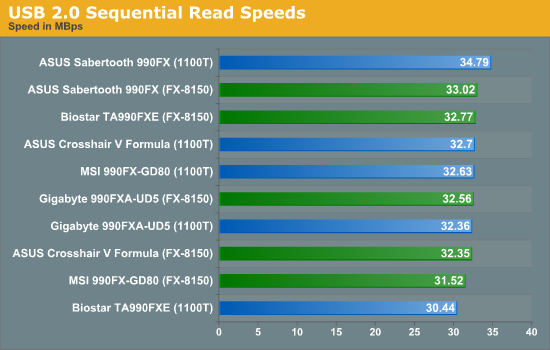
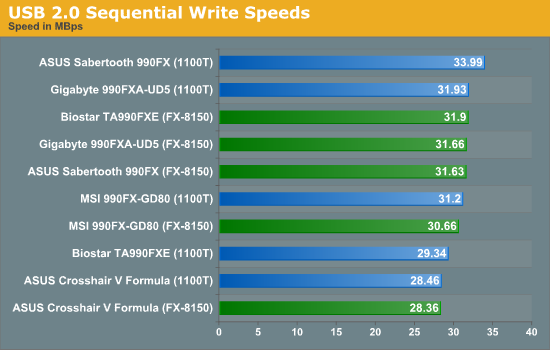

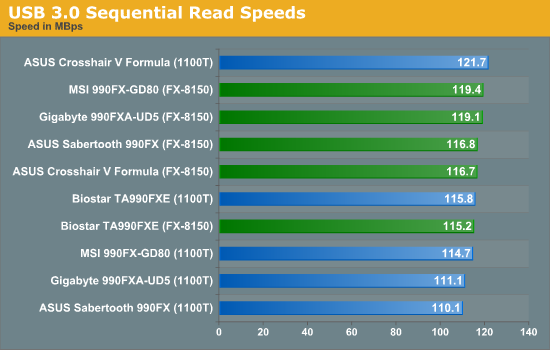

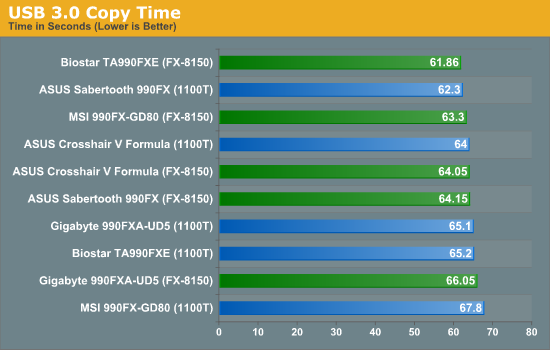
A lot of how the system deals with USB interactions is based on the hardware, including BIOS stated priorities, but also on the software and drivers supplied. This results in our spread on USB 2.0 and USB 3.0 speeds/times. On the whole the Sabertooth 990FX is a good performer, while the MSI tends to lag behind in real world testing.
SATA Testing
We also use CrystalDiskMark for SATA port testing. The operating system is installed on the SSD, and the sequential test is run at the 5 x 1000 MB level. This test probes the efficiency of the data delivery system between the chipset and the drive, or in the case of additional SATA ports provided by a third party controller, the efficiency between the controller, the chipset and the drive.
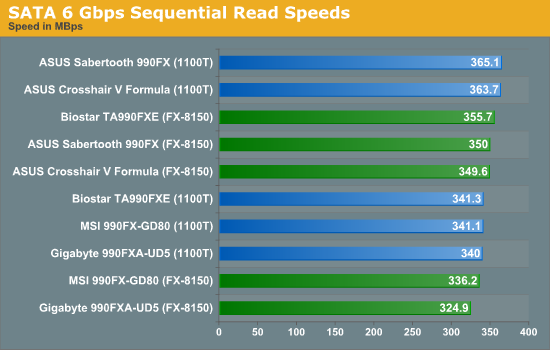
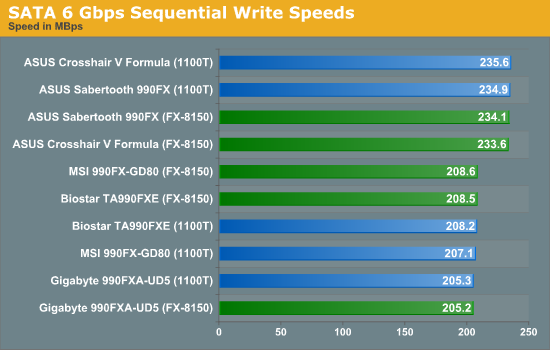
For SATA testing, again we get a processor independent spread. The interesting thing here is the SATA 6 Write results, in which the ASUS boards clearly have an advantage over the other products. This is most likely due to more agressive BIOS settings at default.
DPC Latency
Deferred Procedure Call latency is a way in which Windows handles interrupt servicing. In order to wait for a processor to acknowledge the request, the system will queue all interrupt requests by priority. Critical interrupts will be handled as soon as possible, whereas lesser priority requests, such as audio, will be further down the line. So if the audio device requires data, it will have to wait until the request is processed before the buffer is filled. If the device drivers of higher priority components in a system are poorly implemented, this can cause delays in request scheduling and process time, resulting in an empty audio buffer – this leads to characteristic audible pauses, pops and clicks. Having a bigger buffer and correctly implemented system drivers obviously helps in this regard. The DPC latency checker measures how much time is processing DPCs from driver invocation – the lower the value will result in better audio transfer at smaller buffer sizes. Results are measured in microseconds and taken as the peak latency while cycling through a series of short HD videos - less than 500 microseconds usually gets the green light, but the lower the better.
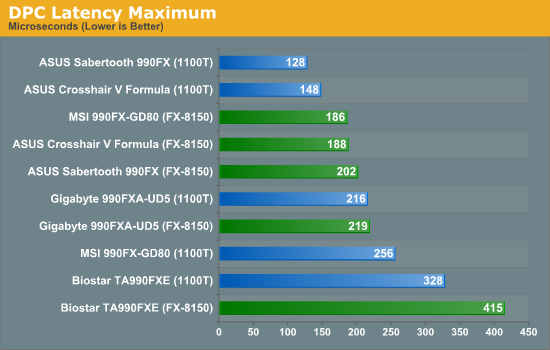
DPC Latency always shows the biggest differences between our motherboards. It is hampered by the fact that it can be disturbed by software. In particular, ASUS' AI Suite and Gigabyte's EasyTune software, when installed, initialise themselves on startup and continuously monitor the motherboard sensors (by pinging them every 3-5 seconds). This request for data has a higher priority, and thus when we do our DPC checks, those boards when the software is enabled shoot up to 3000 microseconds or more. For these tests, we disable the software (as it shows uncharacteristic spikes) to take a reading while playing HD video. In this case, we can confirm that ASUS do it best, and you get what you pay for with respect to the Biostar motherboard.










57 Comments
View All Comments
Mathieu Bourgie - Friday, April 6, 2012 - link
Here's hoping*john21108 - Friday, April 6, 2012 - link
I read the review and didn't see the FX-6200 getting walked over. The benches were all pretty close; the FX, X4, and the X6 all trading blows. At worse, the FX-6200 performed similar to the X4 980; at best, it would barely beat the X6 1100T.The FX looked good to me considering the X6 1100T is going for $240+ on eBay. If building new, is same performance worth an extra $70? Is it an upgrade to an X4 BE or X6, no.
estarkey7 - Thursday, April 5, 2012 - link
I am disappointed in this article for a number of reasons, most of all that the preface of this article had very little to do with the content at all. You start off by stating:"...despite the fact that Windows 7 (and Windows 8, natively) is now receiving updates so the operating system can understand the processor architecture a little better, and hopefully boost performance. This gives a second wind to those owning (or thinking of owning) a Bulldozer based processor, and in turn, a 900-series motherboard."
With that being a defining point of this article, where are before and afters? I and everybody else on here already know what Anand did (hell, we read this site multiple times a day!). Why should I give this platform a second look?. Your preface led me to believe that I would see benches of these motherboards before and after firmware revisions or more importantly firmware revisions and Win 7 vs. Win 8 preview.
It doesn't even make sense to run a full set of benches against motherboards with the same processor at stock speeds, as the differences will surely show in their overclocking potential and feature sets.
Do you even realize that after reading this article that every single reader of Anandtech.com learned absolutely, positively nothing about Bulldozer vs. Thurban vs. Intelxxx that they didn't already know before they wasted 15 minutes of their time?
Why not just delete it, and we'll forget you ever wrote it...
IanCutress - Thursday, April 5, 2012 - link
The purpose of the review was to look at the motherboards and the differences between them, not the absolute performance of the processors. Hence why this review is listed under the motherboard section rather than the CPU section, and the paragraph you quoted ended with the phrase, with appropriate pauses to create emphasis on, 'a 900-series motherboard'. The initial paragraph created purpose and the fact that there is reason to perhaps own one of these motherboards, generating the context and situation to which they are currently in.Anyway, as a regular reader of Anandtech, surely you recognise me as the motherboard reviewer for the past year or more? :)
Ian
estarkey7 - Thursday, April 5, 2012 - link
Ian,I let my recent bulldozer system build get the best of me!
I retract my statement. I believe my attack on you was not reasonable and served no purpose. Although I do disagree with some of the phrasing in the intro paragraph, my post was not warranted and I sincerely apologize.
Keep up the good work.
Ed
Dekkatek - Thursday, April 5, 2012 - link
I don't know if anyone else noticed this, but there is a galler pic of the ASUS Crosshair board with a 4 video card setup and the 4th card is not physically connected to the motherboard!http://www.anandtech.com/Gallery/Album/1843#13
IanCutress - Thursday, April 5, 2012 - link
Haha nice catch :) Most of those images are from ASUS' media kit for the board - I think I must have looked at it and thought they were using the ROG Xpander for four-way. Looking at the Xpander page now, it was only ever compatible on the R3E and R3F.Ian
Makaveli - Thursday, April 5, 2012 - link
When did you need a $1000 extreme edition cpu to be an enthusiast.I'm not really sure what point you are trying to make.
A i7 920 a 2500k or 2600k are all enthusiast cpu that cost less than $400. And all outperform AMD current line up.
It like you are trying to be like AMD before they launched BD comparing it the 990x and saying look out processor is better and doesn't cost $1000 don't make me laugh.
If you are gonna troll you better start doing a better job.
cocoviper - Thursday, April 5, 2012 - link
$1000? Try any CPU over $240.http://www.anandtech.com/show/4955/the-bulldozer-r...
http://leapvine.com/p/1237/Intel%20Core%20i7-2600%...
CPU price ranges tend to range between $50 and $1000 in the retail market. AMD's fastest solution captures the lowest 25% of this market, leaving 3/4 of the price range, and the range with the best margins, to Intel. We all want AMD to be competitive again like they were in the late 90s/early 2000s but they simply aren't.
AMD has also officially stated they have no intention to compete in the performance / enthusiast segment. Per Anand:
"As AMD's client strategy is predominantly built around APUs, the only high-end desktop parts we'll see from AMD are low-end server CPUs. Socket-AM3+ has a future for one more generation and we'll likely see other single-socket, high-end platforms for the desktop. The days of AMD chasing Intel for the high-end desktop market are done though. That war is officially over."
http://www.anandtech.com/show/5503/understanding-a...
BaronMatrix - Thursday, April 5, 2012 - link
Why doesn't anyone use the recommended GPU? If I buy an 8150, it will at least get a 6970 but probably a 7970.No wonder I left this "review site" stuff alone. I can't learn anything except that people think there are 50 CPU makers and AMD is the worst.
Good luck with that.